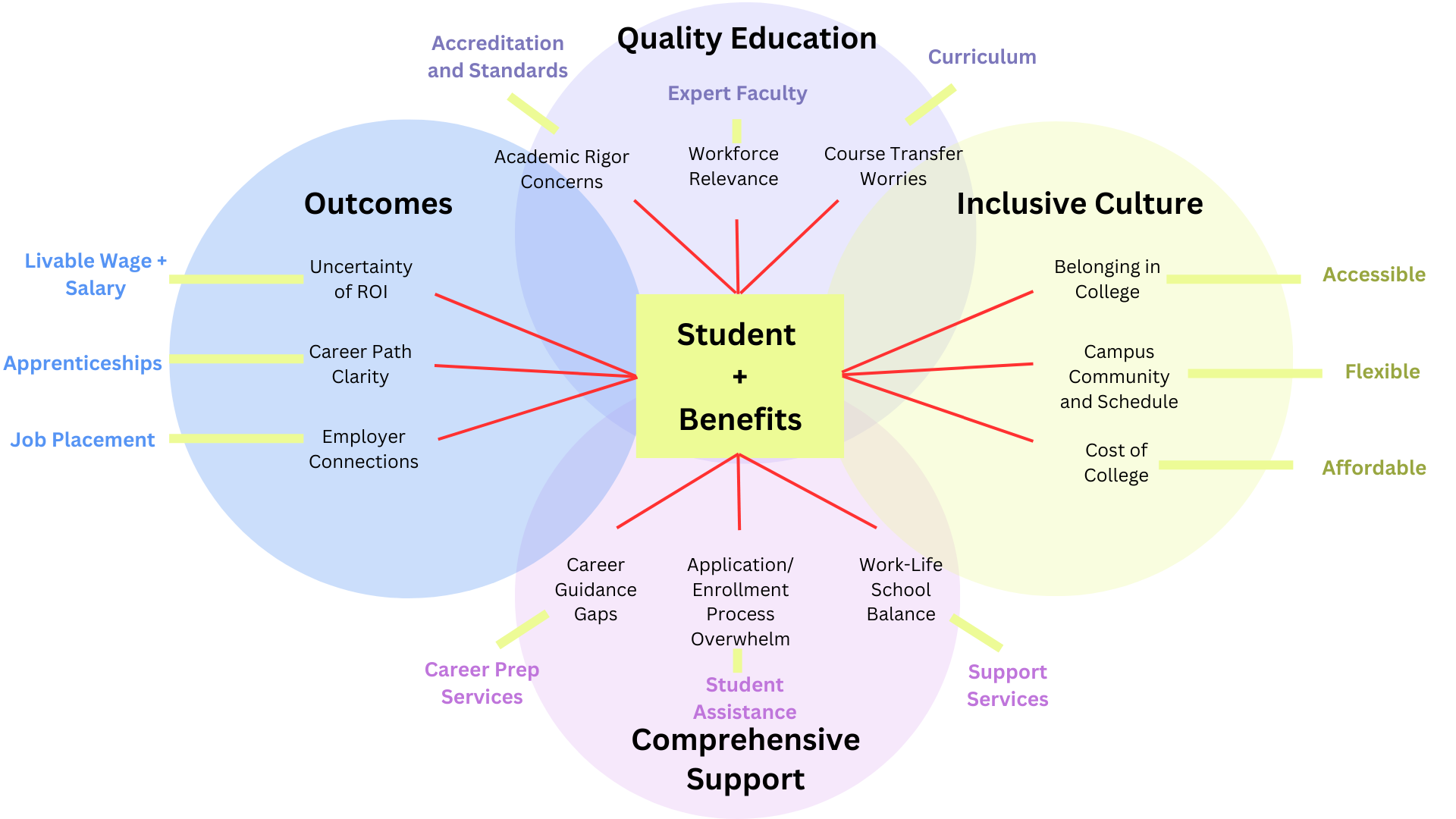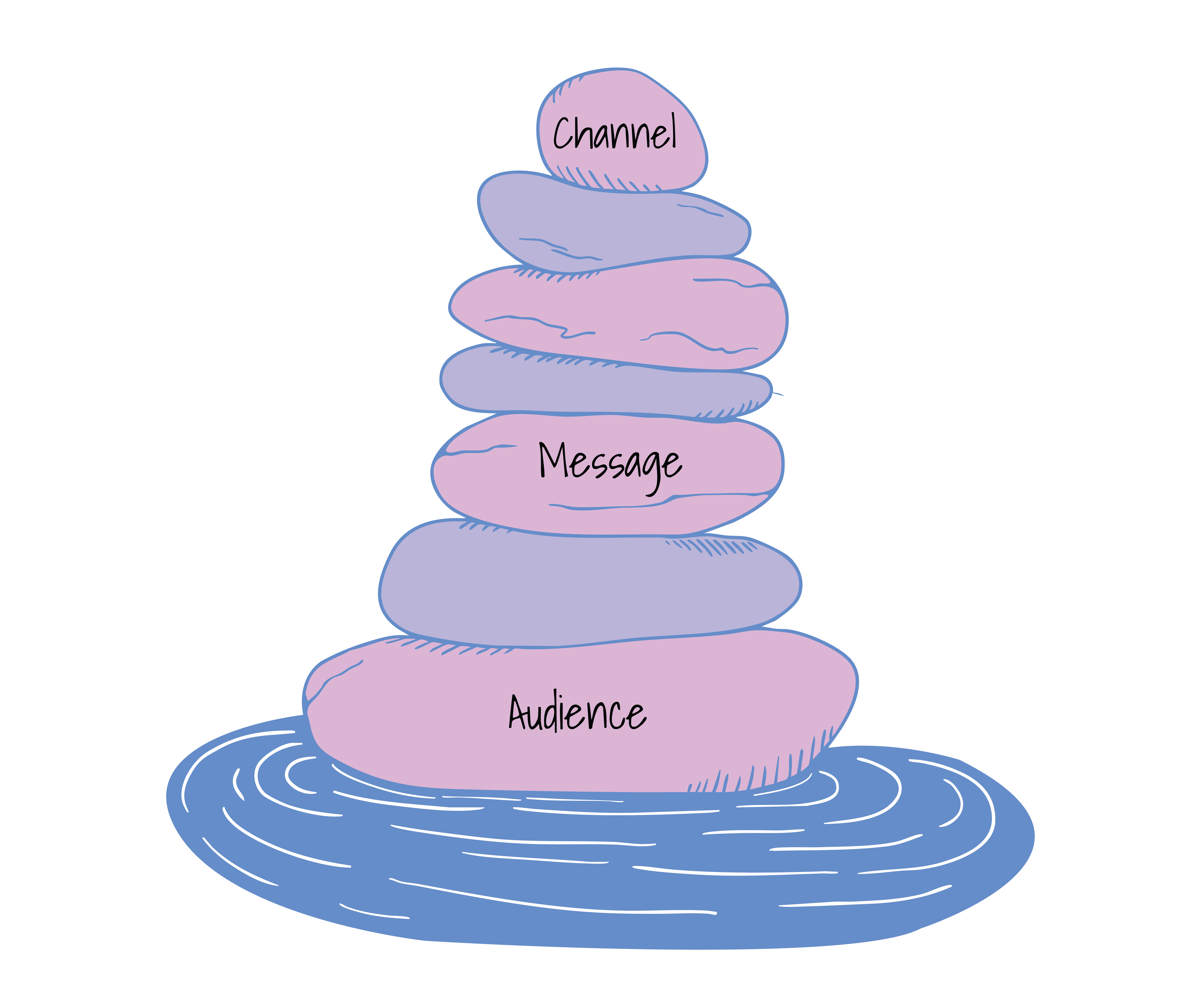Visibility Feels Like a Moving Target Because It Is
Community college visibility isn’t one thing, it’s everything, all at once.
You’re trying to reach everyone and someone:
- The general public and under-enrolled groups
- Through traditional channels and whatever’s trending
- With brand consistency and real-time responsiveness
It’s a balancing act between broad awareness and specific impact. And it keeps shifting while you manage it with any combination of the following: hefty constraints: small team, tight budget, short enrollment windows, and a long list of competing priorities.
There’s a tug of war between:
- Be everywhere – More Visibility! (because community college students could, technically, be anywhere)
OR
- Be targeted – Make every dollar and message count (because your budget definitely isn’t unlimited)
Visibility feels like a moving target. The audience keeps shifting (hello, demographic cliff?). The platforms keep changing (TikTok, Substack and yes, I’m officially calling ChatGPT a “platform” now). And the pressure to “show up everywhere” never really goes away, especially when students could technically be anywhere and we all have strong opinions about what channels we should be on.
So when a new channel pops up, it’s easy to chase it.
When a campaign doesn’t land, the instinct is to add more.
Most colleges aren’t running too few campaigns. They’re running campaigns that lose sight of the why: the real audience, the message that matters to them, and the best place to reach them.
The Visibility Pyramid: Audience → Message → Channel
It’s not revolutionary to say that visibility depends on the right audience, the right message, and the right channel, but what this means for community colleges is unique.
As all-access colleges, it can feel like you are supposed to reach everyone. Yet, when you try to reach everyone, you end up reaching no one.
That’s why focus matters. Whether you’re rolling out a new campaign, launching a program, or shifting your brand, choices need to be made. Should you change the message? Try a new channel? Reach a different audience?
Here’s what I’ve seen again and again: when you start with who, everything else gets easier
→ because your message has someone real to speak to
→ because your channels (and paid advertising) are built for demographic targeting
→ because your visibility efforts begin to align instead of scatter
That’s the power of an audience-first approach. Everything builds from there.
1. Audience: Who are we trying to reach, and what do we know about them?
Your audience isn’t “the whole community.” It’s a set of overlapping groups with different motivations, barriers, and touchpoints. The better you define who you’re trying to reach, the smarter every step after becomes.
Visibility should begin with one key question:
Who’s missing, and why?
Use this formula:
Community Demographics (without a baccalaureate degree)
– Current Enrollment
= Strategic Opportunity
Audience isn’t a vague concept. It’s measurable.
Demographics like age, race/ethnicity, income, veteran status, and education level reveal not just who is showing up, but who isn’t.
That’s where strategy begins.
Because here’s the thing: audience demographics aren’t just numbers. They’re how every major platform (Meta, Google, YouTube, etc.) lets you target. You don’t advertise to “everyone.” You filter by age, zip code, education, interest, but those filters only work if you know who you’re trying to reach.
⬆️ This is what your paid media company should be doing for you!
Skip this step, and you’ll base your message, channels, and budget on guesswork.
Ask yourself:
- Which audiences are underrepresented in our enrollment compared to our service area?
- Do we have data that shows where the biggest gaps or drop-offs are?
- What might motivate this group to consider us?
You can’t build truly effective visibility without understanding where the disproportionate gaps are.
This is where strategy begins.
If pulling audience data feels overwhelming, Most Likely to Succeed can help. IPEDS and Student Information Systems aren’t always easy to navigate, but we offer a service designed to help colleges identify which student groups are missing from enrollment.
2. Message: What matters to them, and what might motivate them to act?
Once you know who, you can tailor what you say.
Different audiences need different stories. Veterans might respond to structure and job placement. Young adults might want flexibility or social connection. Working parents might need cost clarity and online options.
Instead of asking, “What do we want to say?”
Ask: “What would make them feel seen, supported?”
A lot of college marketing focuses on what the college offers:
100+ programs. Flexible classes. Great support.
But effective messaging also speaks to what students need to hear:
- That they belong
- That it’s not too late
- That their goals are valid
- That this college understands their path
And that message changes depending on whether you’re speaking to:
- A veteran
- A working parent
- A recent high school grad who isn’t sure if college is for them
Your message needs to be audience-specific, and speak to their concerns + context beyond “apply now”.
Here’s an example below using the community college positioning pillars to outline student concerns and college benefits.

3. Channel → Where are they, and how can we meet them there?
Once you know who you’re trying to reach and what you’re trying to say, then it’s time to choose the right channels. But “channel” doesn’t just mean one ad platform or social media post, it’s about how you show up across your visibility efforts.
Here’s one of my favorite examples:
A group of men, each in their 60s and 70s, started walking into the admissions office holding a local newspaper advertising the college’s computer basics class.
It wasn’t flashy. It wasn’t digital. But it was the perfect fit:
The right message — basic computer skills
In the right place — the local paper
Seen by the right people — retirees who still read print (we love it!)
A perfect example of how when you start with your audience, your platform decisions become obvious.
That’s where the PESO model by Spin Sucks comes in. Think of PESO as your channel toolbox.
Paid, Earned, Shared, and Owned are your full mix of visibility tools:
- Paid = Targeted ads to specific demographics because your targeting in paid channels is dependent on the demographics of your audience (think: zip code, language, age, keyword). Not all channels have the same demographics for targeting.
- Earned = Getting local media, community partners, or influencers talking.
- Shared = What gets reposted, reshared, or organically picked up.
- Owned = What you fully control (website, emails, landing pages).
Once you know your audience, you can pick the right tools for the job.
A Quick Note on Program Promotion
If you’re starting with a specific program, good news, you’re already ahead of the game. You know what you’re promoting, which means you can focus on what makes it great. But the same visibility logic still applies:
Audience → Message → Channel
You still need to ask:
-
- Who is most likely to want this? Is it someone already working in the field? A career changer? A student with some credits but no credentials?
- What would make them say yes? Apprenticeships? Paid certifications? Guaranteed job interviews?
- Where can we reach them? That’s where PESO comes in.
- Who is most likely to want this? Is it someone already working in the field? A career changer? A student with some credits but no credentials?
Just because a program is new doesn’t mean people will care. Successful programs start with a real audience, a message that matters, and a smart plan to promote it.
And if you want help building it out for a specific program, I’ve got a free training here:
Webinar: How to Build a Program Marketing Plan
Visibility That Works
Community college visibility will always feel like a moving target because your audiences shift, your platforms evolve, and your priorities compete for attention.
But the way to stay on target isn’t chasing every trend or trying to be everywhere at once.
It’s starting with who.
Audience first. Message next. Channel follows.
In the ever-changing landscape of visibility, your audience is your first trail marker to help you choose the right path forward.

